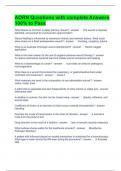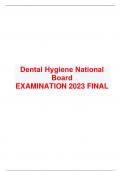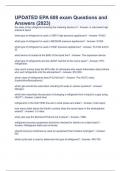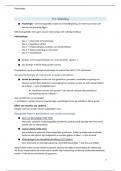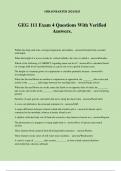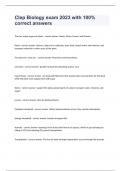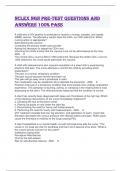Lecture 1: Cost and Airline Types
Fixed costs
Committed fixed costs: do not vary with output, and cannot be readily changed.
Discretionary fixed costs: do not vary with output, but can be changed readily (e.g.
advertising).
Scale consists of two elements
1. Network size: number of nodes or total length.
2. Network density: output per unit of size.
Density economies: average cost decreases with density.
Cost per passenger on a link decreases if the number of passengers travelling on that link
increases. Returns to density when !" < $".
1 3" 456756
RTD = , where *2 = ⋅
*+ 3456756 "
Why economies of density?
• Larger aircrafts burn more fuel, but operating cost per passenger are low.
• Higher densities (passenger flow) allow for more flight hours per day.
• Higher densities (passenger flow) allow for more intensive use of ground facilities.
Economies of size: average cost decreases with network size.
When we increase the number of destinations in the network, the average cost per
passenger decreases.
1 3" :;<74<6=
RTD = , where *2 = ⋅
*+ + *2 3:;<74<6= "
Airline pricing
What are important aspect of travelling?
• Trip purpose → business, leisure, or VFR.
• Timing → peak load problem.
What you want to pay depends on the net value of the activity of your trip purpose.
,Demand characteristics: business vs. leisure travelers
Business Leisure
• Relatively high WTP • Relatively low WTP
• Relatively insensitive to prices • Relatively sensitive to prices
(inelastic). (elastic).
• Small proportion (high income) of • Low cost airlines made air
population responsible for travel available to the
disproportionally large number of masses of population.
trips.
Segmenting
Demand segmentation: identify groups of passengers so that service design and prices are
group specific.
Demand management
• You want passengers that pay high prices (keep some seats open: inelastic demand).
• You need passengers that are not willing to pay high prices (elastic demand).
Different fares for different segments (price discrimination).
• Based on preferences.
• Maximizing revenues (cost fixed in short run).
• Overbooking: rely on the fact that some passengers don’t show up.
Airline types
Conventional airlines
• Legacy airlines → established prior to deregulation 1978 (KLM).
• Network airlines → hub-spoke network.
o Hubs are central airports.
o Focusses on one or more hubs.
o Passengers between non-hub airports fly indirectly.
§ Exploitation of density economies → larger aircruft is used, or aircraft is
used more intensively on remaining routes.
• Full service airlines → relatively high services.
Segmentation for conventional airlines
• High frequencies for high yield passengers.
o Business and leisure flying direct: high ticket classes.
• Fill remaining seats with low yield passengers.
o Leisure flying direct: low ticket classes.
• Indirect travelers: low ticket classes.
• Shift to commodity: low cost airlines made air travel available to ‘other classes’.
• Network must allow for transfers, high indirect cost.
Low cost airlines
Deregulation opened markets for new scheduled airlines.
• Strategy LCC: eliminate everything not essential to the core product → a flight
between origin and destination.
• Negotiated contracts in deregulated environment (different labor contracts, lower
wages and low direct cost).
• Differentiated strategies
o No primary airports, no hub-and-spoke network, single aircraft type,
outsourcing, no extensive yield management (price discrimination). But there
is no standard low cost strategy. Simple network: low indirect cost.
• Success stories: Ryanair, Easyjet, SouthWest (US).
• Failures: expansion into thin markets and increasing competition between LCCs.
, Responses of conventional airlines to LCCs
• Bankruptcy.
• Renegotiation of labor contracts.
• Efficiency gains (mainly on short haul).
• Setting up own LCCs.
Network Convergence
• Conventional airlines unbundle their services.
• Low cost airlines offer attributes that add value (for money): hybrid model.
• Gudmundsson (2015): This trend signifies a break away from strategy principles that
would hold that best performing firms are at the extreme opposites of the scale, rather
than hybrids.
Lecture 2: Network Optimality I
Learning objective: be able to explain the optimality of certain network types from a cost
perspective.
Hub-Spoke Networks
A hub is an airport that generates at least 0,05% of enplanements.
• 0,05 - 0,25% → small.
• 0,25 - 1% → medium.
• > 1% → large.
Network where only the hub is connected (directly) to all other airports. Travelling between
two airports that are not hubs requires a transfer at the hub.
Central point in an airline network (spatial concentration), which functions as a transfer
point for all passengers not travelling from or to the hub (temporal concentration).
Fixed costs
Committed fixed costs: do not vary with output, and cannot be readily changed.
Discretionary fixed costs: do not vary with output, but can be changed readily (e.g.
advertising).
Scale consists of two elements
1. Network size: number of nodes or total length.
2. Network density: output per unit of size.
Density economies: average cost decreases with density.
Cost per passenger on a link decreases if the number of passengers travelling on that link
increases. Returns to density when !" < $".
1 3" 456756
RTD = , where *2 = ⋅
*+ 3456756 "
Why economies of density?
• Larger aircrafts burn more fuel, but operating cost per passenger are low.
• Higher densities (passenger flow) allow for more flight hours per day.
• Higher densities (passenger flow) allow for more intensive use of ground facilities.
Economies of size: average cost decreases with network size.
When we increase the number of destinations in the network, the average cost per
passenger decreases.
1 3" :;<74<6=
RTD = , where *2 = ⋅
*+ + *2 3:;<74<6= "
Airline pricing
What are important aspect of travelling?
• Trip purpose → business, leisure, or VFR.
• Timing → peak load problem.
What you want to pay depends on the net value of the activity of your trip purpose.
,Demand characteristics: business vs. leisure travelers
Business Leisure
• Relatively high WTP • Relatively low WTP
• Relatively insensitive to prices • Relatively sensitive to prices
(inelastic). (elastic).
• Small proportion (high income) of • Low cost airlines made air
population responsible for travel available to the
disproportionally large number of masses of population.
trips.
Segmenting
Demand segmentation: identify groups of passengers so that service design and prices are
group specific.
Demand management
• You want passengers that pay high prices (keep some seats open: inelastic demand).
• You need passengers that are not willing to pay high prices (elastic demand).
Different fares for different segments (price discrimination).
• Based on preferences.
• Maximizing revenues (cost fixed in short run).
• Overbooking: rely on the fact that some passengers don’t show up.
Airline types
Conventional airlines
• Legacy airlines → established prior to deregulation 1978 (KLM).
• Network airlines → hub-spoke network.
o Hubs are central airports.
o Focusses on one or more hubs.
o Passengers between non-hub airports fly indirectly.
§ Exploitation of density economies → larger aircruft is used, or aircraft is
used more intensively on remaining routes.
• Full service airlines → relatively high services.
Segmentation for conventional airlines
• High frequencies for high yield passengers.
o Business and leisure flying direct: high ticket classes.
• Fill remaining seats with low yield passengers.
o Leisure flying direct: low ticket classes.
• Indirect travelers: low ticket classes.
• Shift to commodity: low cost airlines made air travel available to ‘other classes’.
• Network must allow for transfers, high indirect cost.
Low cost airlines
Deregulation opened markets for new scheduled airlines.
• Strategy LCC: eliminate everything not essential to the core product → a flight
between origin and destination.
• Negotiated contracts in deregulated environment (different labor contracts, lower
wages and low direct cost).
• Differentiated strategies
o No primary airports, no hub-and-spoke network, single aircraft type,
outsourcing, no extensive yield management (price discrimination). But there
is no standard low cost strategy. Simple network: low indirect cost.
• Success stories: Ryanair, Easyjet, SouthWest (US).
• Failures: expansion into thin markets and increasing competition between LCCs.
, Responses of conventional airlines to LCCs
• Bankruptcy.
• Renegotiation of labor contracts.
• Efficiency gains (mainly on short haul).
• Setting up own LCCs.
Network Convergence
• Conventional airlines unbundle their services.
• Low cost airlines offer attributes that add value (for money): hybrid model.
• Gudmundsson (2015): This trend signifies a break away from strategy principles that
would hold that best performing firms are at the extreme opposites of the scale, rather
than hybrids.
Lecture 2: Network Optimality I
Learning objective: be able to explain the optimality of certain network types from a cost
perspective.
Hub-Spoke Networks
A hub is an airport that generates at least 0,05% of enplanements.
• 0,05 - 0,25% → small.
• 0,25 - 1% → medium.
• > 1% → large.
Network where only the hub is connected (directly) to all other airports. Travelling between
two airports that are not hubs requires a transfer at the hub.
Central point in an airline network (spatial concentration), which functions as a transfer
point for all passengers not travelling from or to the hub (temporal concentration).


